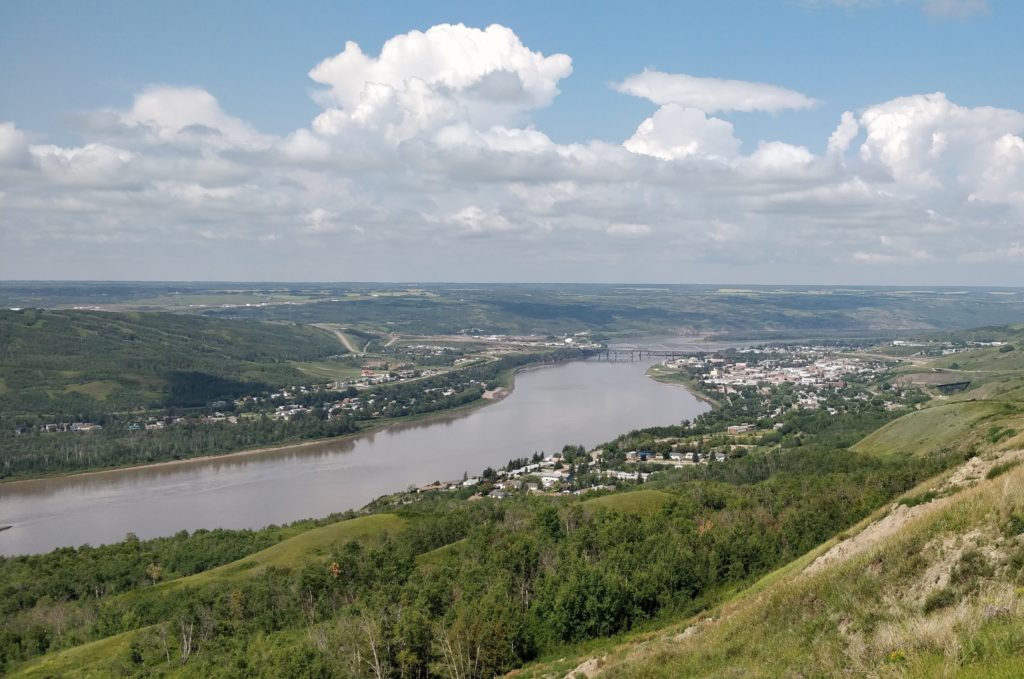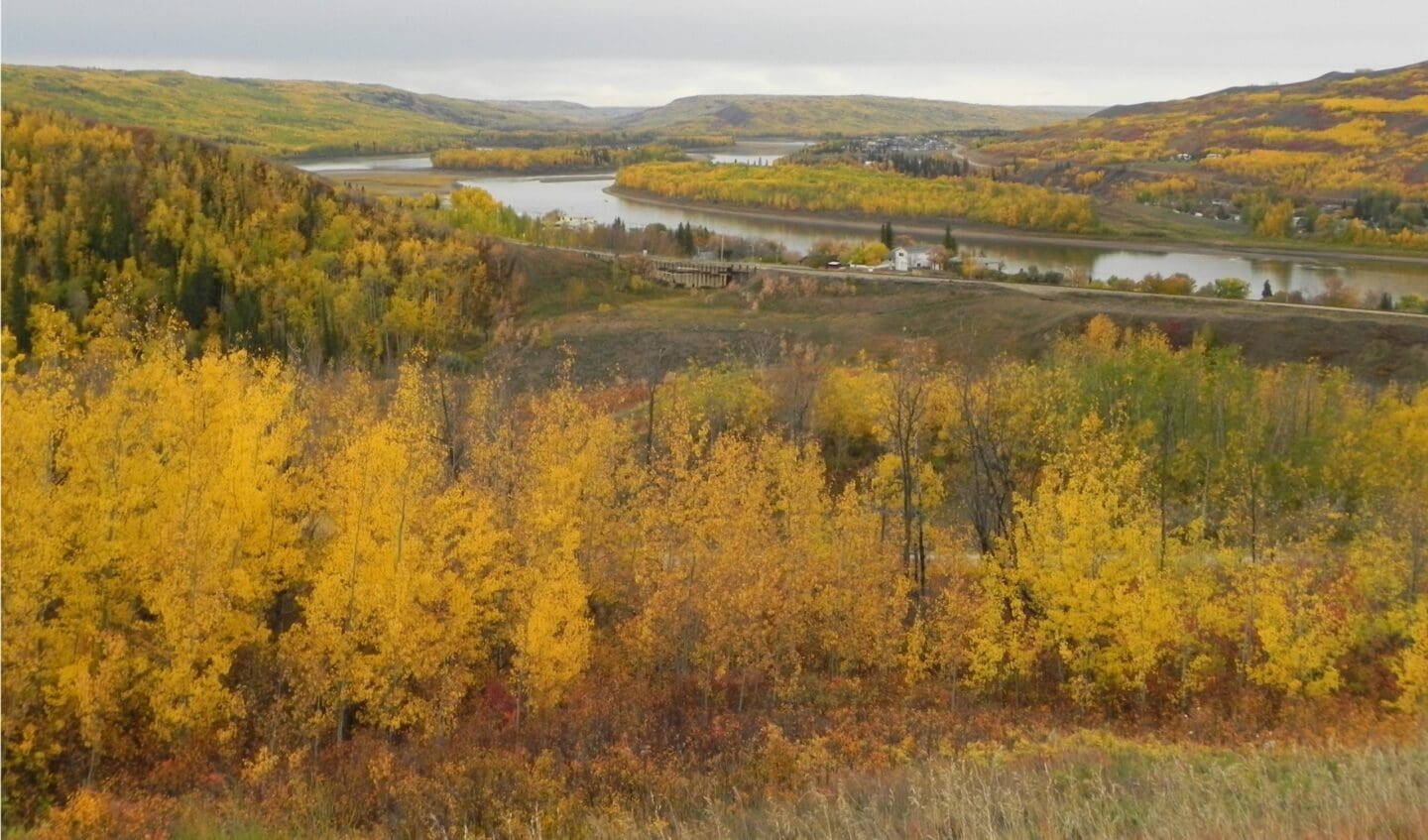In the summer of 2016, I began my fieldwork study of the oil and gas industry in Alberta. I studied the relationship between Indigenous land users, resource extraction, and the environment. This is how I first came to visit the Town of Peace River.
The Peace River Formation is a part of the Western Canadian Sedimentary Basin in the landform region of the Alberta Plateau. The Peace River Formation consists of coal, sandstone, and shale and is roughly 18 meters (60 feet) thick. The Town of Peace River is located within the Peace River Formation.
Resulting from territorial negotiations between the Athapaskan and Algonquian Tribes, and with some early influence from the Hudson Bay Trading Company, Unchagah, or the Peace River, became a recognized boundary between hunting territories. Later, the Peace River area became a bustling spot for trade, and, later still, an important player in Alberta’s oil and gas industries.
It was from my fieldwork site deep in the boreal forest I would begin the drive to Peace River for groceries and gas. Through the rolling foothills of the Eastern Slopes, I would pass giant boulders, spots of lake water, wild roses, and a vast forest of green.
Aspen and balsam poplars, white birch, tamaracks, and jack pines, became a blur of green rushing past the car window. The drive was a welcomed period of meditation and an opportunity to leave the field from time to time. I would use the calmness of the drive to think about my research, my experiences, and, my family and friends who I missed.
Fieldwork can be a wonderful time of connection because you are constantly meeting new people, forming new relationships, and exploring new places and experiences. As fun and interesting as that can be, fieldwork can also be a time of disconnection. You can often feel left out of the life you are used to living at home.
Originally from Saskatchewan, I often felt lonely and isolated while in the field and even though I made good friends and contacts while there, I found myself looking for connection in a variety of ways. I would spend time in nature. I drove deep into the forest, visited lakes and spent time on the water, hiked, meditated, did yoga.
I would read books, ethnographies, and news articles. I would spend a good deal of time writing. I would write field notes, ideas, thoughts, short stories, and poetry. These connections to nature and to my art came naturally because these are things I spend time doing in my ordinary life — but in unordinary circumstances like living in the field, you begin to yearn for something different.
As an anthropologist, you are required to construct an identity that embodies theoretical and methodological perspectives embedded in the discipline and while this is an important part of skill development, it can sometimes be restricting. For example, you likely would not speak to a research participant with the same tenderness you would to your child. So while my anthropological self is authentic, it does not always allow me to fully relax. This contributed to the sense of disconnection I was feeling at the time.
When I felt lonely, I would sometimes tune into different social media platforms to see what friends from home were doing. One morning, I opened my Instagram account to see hundreds of people discussing a new game called PokémonGo.
This game, based off of a popular cartoon, invited players to collect different types of Pokémon — with a catch. In order to catch Pokémon on the game, you had to physically walk to the site destinations where Pokémon were located.
The app used Google Maps to track your progress. Each site destination is typically an important local spot with historical, spiritual, or cultural significance and an informational blurb pops up each time you walk there.
As a big Pokémon fan, I was intrigued to play, but mostly, I wanted to join the online community of thousands of people playing this game.
Peace River was the closest place that had cell service, so, when the next weekend rolled around, I quickly hopped in the car and drove to town.
I parked the car and was online in seconds. My avatar was placed on the map and suddenly, site destinations began popping up! Right in front of me was the historic building of the T.R. Wilson’s Dry Good Store. The app told me that it is built in the Masonry style and that it is one of the oldest commercial buildings in the town. I looked up from the game and took in the storefront. I noticed the corbelled brick cornice and brick pillars and large windows.
As I entertained going inside, a ding from my phone pulled my attention back to the game — a Pidgey! My first battle had begun! In seconds, I had captured my first Pokémon and my map popped up again, urging me forward to the next destination.
I turned my phone and headed down a new street, where I discovered the historic Clarke Residence with the formidable stone wall feature, the Mt. Pleasant Cemetery, the Athabasca Hall, and parts of the Grouard Trail. I visited the Twelve Foot Davis Statue, the railway museum, and the incredible Sagitawa Lookout.

At a beautiful bed and breakfast near the river, a woman stopped me to say that she had been watching me make my way through the park, down the street, and towards the river. She inquired after what I was busy doing and I told her about the game.
We ended up talking about the town and it’s many sites for half an hour! She was proud and pleased that I had spent my day exploring and told me to take a minute to walk the hill to the river trail, that views there were stunning in summer.
So, huffing and puffing my way up the side of the river bed, I was absolutely gob-smacked. She wasn’t exaggerating, the river laid out before me was remarkable. Like something out of a movie, showing the untouched world of ancient times, the river thundered by, stretching beyond my view, turning around the bend and out of sight.
Though I was not in the Peace River area to study, much of me research relates to the basin as oil and gas energies are among the primary resources extracted in the area.
Groups, including Keepers of the Athabasca and others, have dedicated their work to preserving and conserving the land and water and suddenly, I knew why. It is not too dramatic to call the landscape completely majestic.
I could not believe that I had been coming to Peace River to get groceries and gas, and had never taken the time to climb the hill to the river, or to see anything else in the town, for that matter.
Now, don’t get me wrong, playing the Pokémon game was very fun. I caught many Pokémon, found eggs, connected with other players online. However, I would never have anticipated the intense connection to the history, the people of the town, or to the surrounding environment that I experienced while playing the game.
I’ve only ever used technology and virtual reality experiences to escape community — not to find it. I had, many times, placed myself in nature to feel connected, but it was a delight to discover interconnectedness between my friends online, the sites of Peace River, nature, and technology.
“I’ve only ever used technology and virtual reality experiences to escape community — not to find it.”
While playing the game, you can snap pictures of yourself and upload them to your maps — several of my friends messaged me afterwards to tell me how beautiful the town was, to ask me more about why I was there, and to comment on the river views. People who had never expressed an interest in my research before, messaged me to inquire about what I was studying because they had seen my photos on the app.
I think that I had only ever experienced what I am going to label as ‘convenient connection’: my feelings of connection came easily because I was in relative proximity to those I cared for and who cared for me.
What I mean, is that I had never found myself in the unique position of being surrounded by people and yet totally devoid of knowing and being known by anyone at all. Even though my fieldwork site was far from home, I knew people there and spent time with them, but in Peace River, I had no personal ties at all. It’s unnerving, and my usual coping mechanisms of turning to nature were not as readily available to me in an unknown place. That is, until I incorporated digital technology and game-making. Suddenly the unknown became familiar, and the mundane became exciting.
If you find yourself in Peace River, turn on PokémonGo, and hike to the Sagitawa Look Out — there’s a Charizard there!
This article was written by Marley Duckett, one of Y2Y’s 2022 story gatherers. These four unique people are sharing personal stories, memories and places related to the special landscapes of Alberta’s Eastern Slopes, often perspectives that are underrepresented in mainstream media. Read other stories in this series.
We are grateful for the financial support provided by Alberta Ecotrust and The Calgary Foundation for our story gatherer series.


